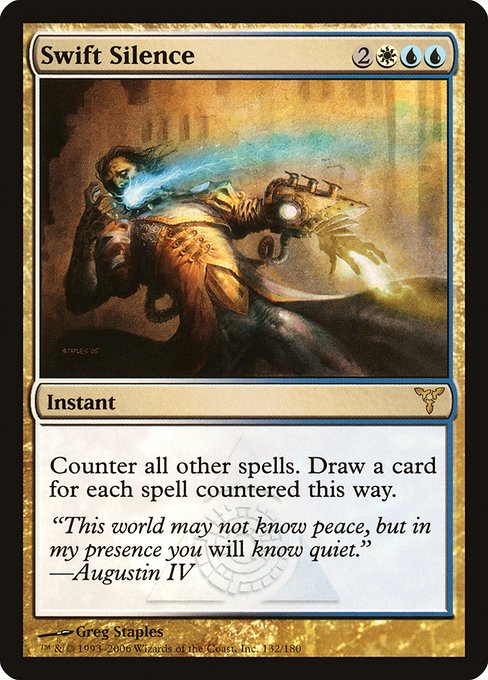
Image courtesy of Scryfall.com
Design risks that paid off: Swift Silence and the Azorius balance
In the sprawling tapestry of MTG’s history, some design decisions feel like quiet experiments that explode into the metagame years later. Swift Silence—an instant from Dissension—stands as a classic case study. The card cost a premium, but the payoff was a dramatic demonstration of how far control can be pushed when a designer balances power, tempo, and interaction. With a mana cost of {2}{W}{U}{U} and a total mana value of five, this rare instant belongs to the Azorius mold: efficient, precise, and a little bit calculating. 🧙♂️
Swift Silence is a two-color beacon for control archetypes, wrapped in a watermark that signals the guild’s approach to order and law: counter everything, then lean on card advantage to outlast the table. Its oracle text—“Counter all other spells. Draw a card for each spell countered this way.”—is as daring as it is elegant. It dares you to weigh the balance between denying your foes’ threats and granting yourself a bounty of fresh options. That calculation is where the design risk shines: a blanket counter spell that can swing the entire game, and a payoff that scales with how many spells your opponents cast. In a world of incremental removal and tempo plays, Swift Silence demanded players rethink when “the right time to reset” actually is. 🔎
The card’s set sits in the Dissension block, a time when Wizards explored guild identities with a tactical lens. The Azorius watermark on Swift Silence isn’t just cosmetic; it’s a statement about governance, order, and procedural magic. The flavor text—though restrained—reminds us that the world may crave chaos, but in some moments, quiet, precise control is the strongest counter to chaos. The art by Greg Staples reinforces that stoic, architectural vibe, framing control as a discipline rather than a reaction. The result is a design that feels inevitable in hindsight: a tool built for the long game, not a one-turn blowout. 💎
In practice, the risk was not merely power; it was consistency and fun factor across formats. Swift Silence is legal in Legacy and Vintage (and in EDH, where it often shines as a political tool that can reset the board at a crucial moment). In Standard-era contexts, it’s not a fit; the card’s strength sits in formats that can leverage ongoing spell-casting and layered responses. That deliberate targeting of eternal formats demonstrates a thoughtful design strategy: create a card that won’t destabilize the entire standard ecosystem while offering a quintessential, memorable play in bigger kingdoms of the game. This is the essence of a swing-for-the-fences risk that pays off—if the environment can accommodate it. ⚔️
From a gameplay perspective, Swift Silence rewards patience and planful play. A control deck that can survive early pressure can mete out a powerful tempo swing by halting the entire spell cascade of an opponent’s turn. The draw mechanic means each countered spell becomes literal value—you’re not just stopping threats; you’re refilling your hand with options to steer the game in your direction. In multiplayer environments, the card’s potential to draw multiple cards can influence political dynamics at the table, turning agreements and disagreements around timing into a strategic chess match. This is the kind of design that rewards reader-friendly decks that respect the rules while inviting clever, interactive decisions. 🎨
Of course, every bold choice invites counterplay. The mass-counter concept invites other players to pack cheaper spells or to pivot toward non-spell threats, testing whether a table can weather a single, decisive counter-war. Yet Swift Silence’s enduring appeal lies in how it demonstrates a deliberate design philosophy: push power when the payoff is predictable and bounded by color identity, and pair it with a vivid, thematic frame. The result is a card that remains a reference point for modern design discussions about control suites, card draw engines, and the ethics of “unfun” power in a game that thrives on memorable decisions. 💎🔥
For collectors and players alike, Swift Silence is a reminder of how a single card can anchor a deck’s strategy while shaping a set’s narrative arc. Its rarity, combined with a striking color identity and a high-impact effect, makes it a sought-after piece for both gameplay and display. The Dissension era is often revisited not just for nostalgia but for lessons in how to push a mechanic without sacrificing the broader health of the game. In the end, the risk paid off in spades: a timeless control spell that invites both dread and delight at the table. 🧙♂️
Phone Case with Card Holder — Impact Resistant Polycarbonate + MagSafeMore from our network
- https://blog.rusty-articles.xyz/blog/post/recalibrated-luminosity-from-space-survey-reveals-hot-blue-giant-at-3-kpc/
- https://blog.digital-vault.xyz/blog/post/baloth-gorger-price-trends-and-collector-value-insights/
- https://blog.digital-vault.xyz/blog/post/hidden-defensive-plays-with-nim-grotesques-ability/
- https://transparent-paper.shop/blog/blog/post/designing-print-ready-textures-with-perfect-color-accuracy/
- https://crypto-acolytes.xyz/blog/post/cardano-vs-avalanche-which-blockchain-reigns-supreme/